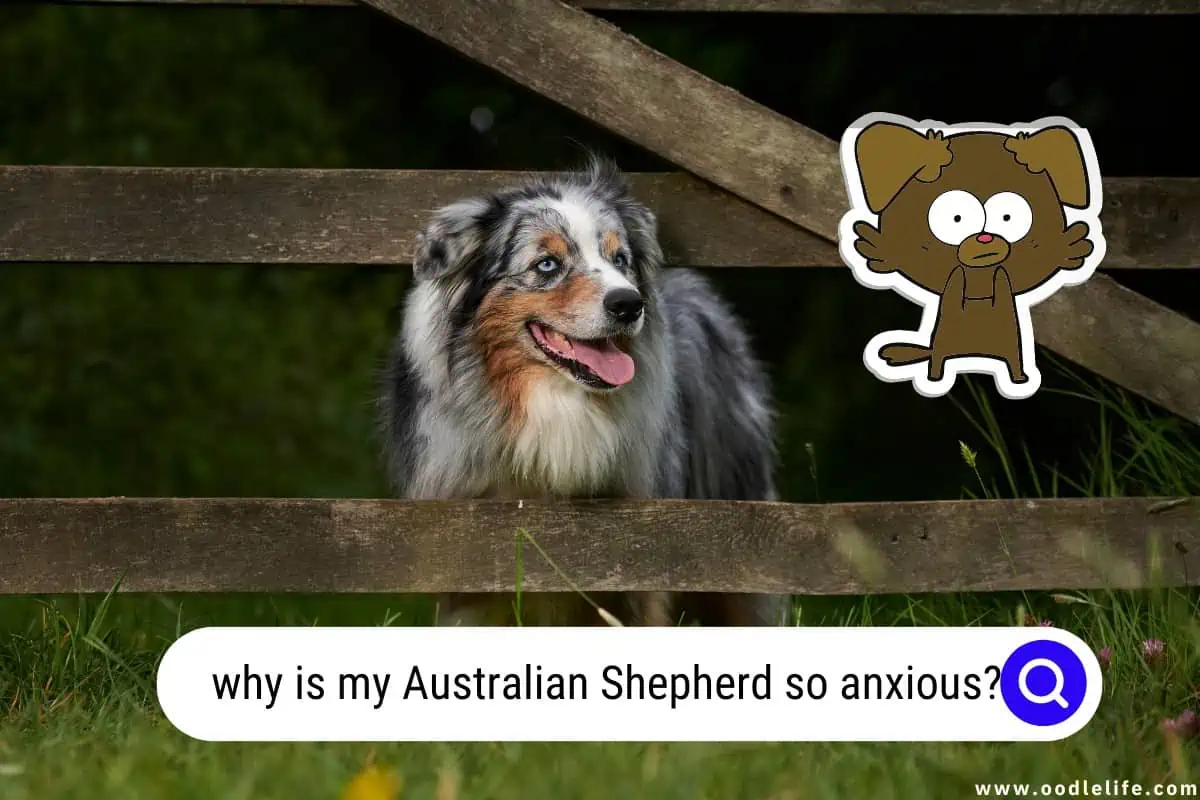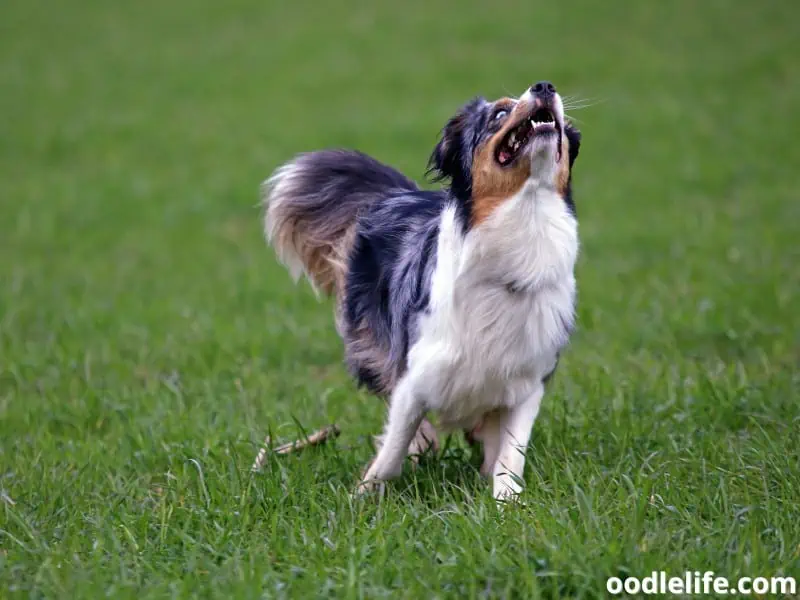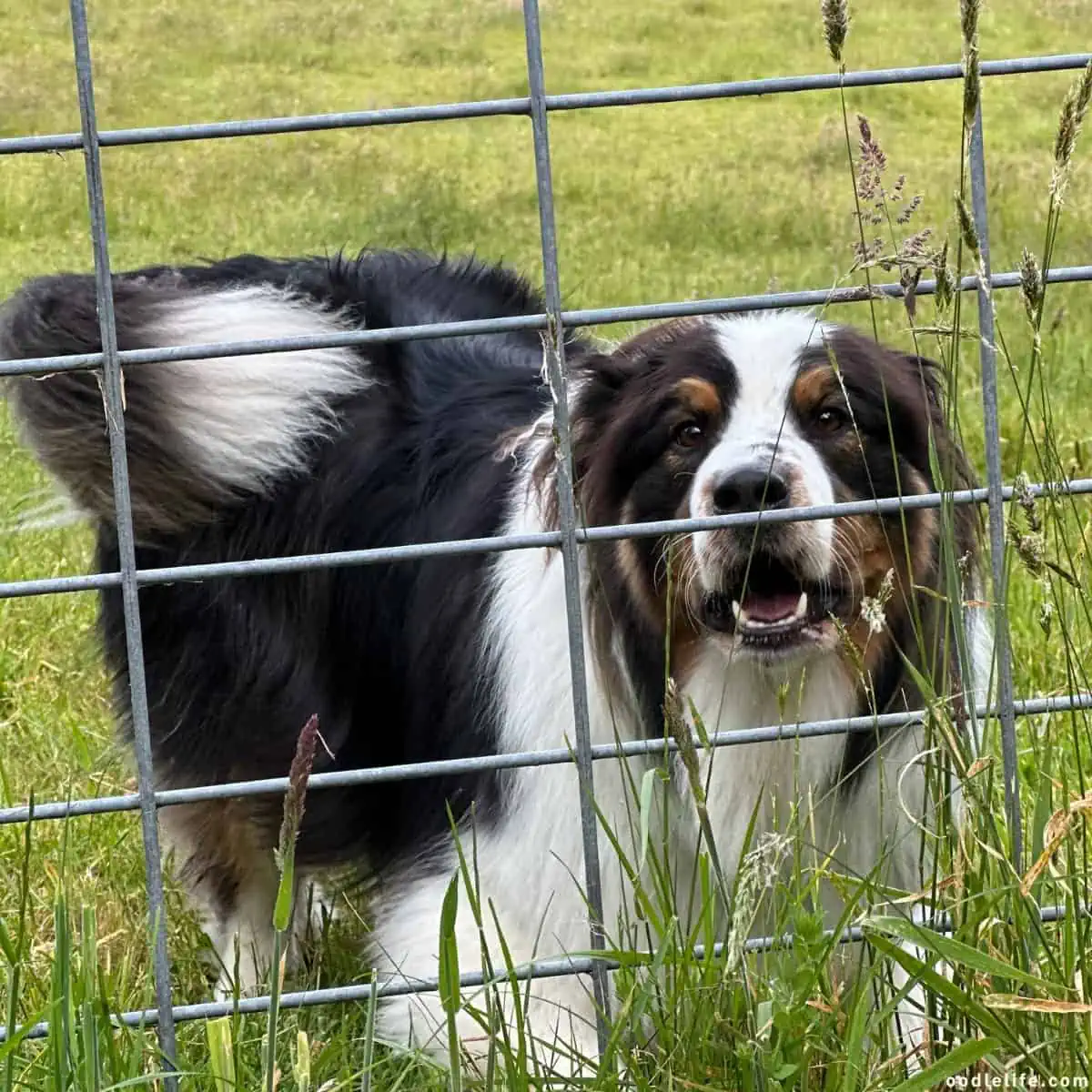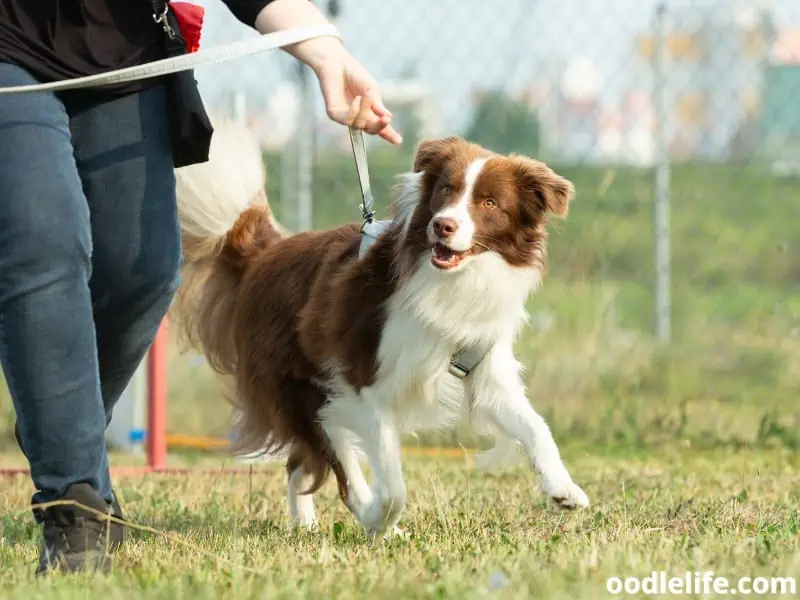Why is My Australian Shepherd So Anxious? Analyzing Causes and Solutions
As a dog owner, you might sometimes wonder why your Australian Shepherd appears to be more anxious than other dogs. While these friendly and energetic dogs are known for their loyalty and intelligence, it’s not uncommon for them to display signs of anxiety in certain situations. Understanding the possible reasons behind your Australian Shepherd’s anxiety can help you manage it better and ensure their well-being.
One possible reason for anxiety in Australian Shepherds is their genetic disposition. Some studies have reported cases of anxiety-related behaviors in this breed, such as lack of menace response and increased sensitivity to certain medications. However, genetics is just one piece of the puzzle, and environmental factors can also play a significant role in shaping an Australian Shepherd’s behavior.

Aside from genetics, another important consideration is an Australian Shepherd’s innate herding instincts and high energy levels. These traits require plenty of physical and mental stimulation to prevent anxiety from manifesting in the form of destructive behaviors. Providing your Shepherd with regular exercise, mental challenges, and positive reinforcement can help mitigate anxiety and keep their minds and bodies engaged in a healthy way.
Remember, it’s essential to evaluate your dog’s specific situation and consult with a veterinarian or professional dog trainer if you’re concerned about your Australian Shepherd’s anxiety levels. They can provide personalized advice and guidance to ensure your pup’s overall well-being.
Understanding Australian Shepherd Anxiety
Australian Shepherds are intelligent and active dogs, making them excellent working companions. However, they can also be prone to anxiety. By understanding the different types of anxiety your Australian Shepherd may experience, you can better support their needs and help them feel more secure.
Separation Anxiety
Separation anxiety occurs when your Australian Shepherd becomes distressed or anxious when they’re away from you. This might happen when you leave for work or if they’re left alone for extended periods. Symptoms of separation anxiety can include destructive behavior, excessive barking, and house soiling.

To help alleviate separation anxiety, establish a daily routine, give your dog plenty of physical and mental stimulation, and consider using puzzle toys or treat-dispensing toys when you’re not around.
Fear-Related Anxiety
Fear-related anxiety is usually caused by something specific, like loud noises or unfamiliar places. Your Australian Shepherd may be more prone to fear-related anxiety due to their sensitivity to changes in their environment. Thunderstorms, fireworks, or even the vacuum cleaner can trigger anxiety in your dog.

Gradually desensitizing your Australian Shepherd to the source of their fear can help lessen their anxiety. For example, you can slowly expose them to the sound of thunder at a low volume and gradually increase it, while rewarding them for staying calm.
Age-Related Anxiety
As your Australian Shepherd ages, they may develop age-related anxiety. This can be attributed to cognitive decline, changes in vision or hearing, or a decreased ability to cope with stress. It’s essential to maintain a consistent routine and provide mental and physical stimulation for your aging Australian Shepherd.

Regular vet check-ups can help address any age-related health concerns, making your fur-baby feel more comfortable.
Remember that every dog is unique. By understanding and addressing your Australian Shepherd’s specific anxieties, you’ll be able to help them feel safer and more secure in their environment.
Signs of Anxiety in Australian Shepherds
Australian Shepherds are intelligent and energetic dogs, which can sometimes lead to them being more prone to anxiety. In this section, we will explore the signs of anxiety in Australian Shepherds and possible reasons behind their anxious behavior.

One common sign of anxiety in Australian Shepherds is being easily startled or anxious when exposed to loud noises or sudden touch. This could be a result of Neuronal Ceroid Lipofuscinosis (NCL), a disorder found in some Australian Shepherds that leads to neurological issues and anxiety-like symptoms.
Another sign can be excessive barking or whining, especially when the dog is left alone. This may be due to separation anxiety or a reaction to unfamiliar situations. Remember, this breed is known for their work as herding dogs, and they may struggle with adapting to a less active lifestyle.
In some cases, Australian Shepherds may display aggression or become overly protective of their owners. This might stem from insecurity or fear and could be a reaction to perceived threats to their owner or home environment.

Some Australian Shepherds may also exhibit destructive behaviors such as chewing on furniture, digging, or pacing. This restlessness can be a sign of pent-up energy or stress. Providing regular exercise, mental stimulation, and consistent training can help alleviate these behaviors.
An important thing to note is that not all signs of anxiety in Australian Shepherds are apparent. Some dogs may excessively groom themselves, continuously lick their paws, or pant when anxious – all of which might be less noticeable.
In conclusion, understanding the signs of anxiety in your Australian Shepherd is crucial to ensure their well-being. Like any other dog breed, each Australian Shepherd is unique, so it’s essential to pay close attention to your furry friend’s behavior. If you notice any potential signs of anxiety, consult with a veterinarian or a professional dog trainer for advice on addressing the issue.
Causes of Anxiety
Genetics
It’s important to note that anxiety in Australian Shepherds can be partly influenced by their genetics. Just as humans can inherit certain traits from their parents, dogs can as well. Some lines of Australian Shepherds are predisposed to being more anxious due to their genetic makeup.

However, genetics is not the sole cause of anxiety in these dogs.
Traumatic Experiences
Traumatic experiences can significantly contribute to anxiety in Australian Shepherds. A traumatic event, such as being attacked by another dog, being abused, or experiencing a natural disaster, can cause long-lasting emotional distress. This distress often manifests as anxiety, making your furry friend more easily startled, nervous, or fearful in certain situations.
Lack of Socialization
Lack of socialization plays a crucial role in the development of anxiety in Australian Shepherds. Proper socialization, which includes exposing your dog to a variety of people, animals, and environments, is essential during their early life stages. When an Australian Shepherd doesn’t receive sufficient socialization, they may become anxious in novel situations or when meeting new people and animals.

Some tips for effective socialization:
- Introduce your Aussie to various people, animals, and environments
- Provide positive, fear-free experiences
- Start socializing your dog at an early age (ideally during their critical socialization window, which is between 3-14 weeks old)
Environmental Factors
Lastly, environmental factors can play a role in causing anxiety in Australian Shepherds. Stressful situations, such as moving to a new home, a change in the family dynamic, or exposure to loud noises like thunderstorms and fireworks, may cause anxiety in your Aussie. Additionally, Australian Shepherds are working dogs, bred for herding and other high-energy tasks; a lack of mental and physical stimulation can lead to anxiety, as well.
It’s important to keep these causes in mind when addressing your Australian Shepherd’s anxiety. By understanding the various factors that contribute to their anxiety, you can take appropriate steps to help your dog feel more at ease. So, next time your Aussie feels anxious, give them some extra love and attention, but also remember to take a step back to address the root causes of their anxiety.
How to Help Your Anxious Australian Shepherd?

Training and Behavior Modification
One of the best ways to help your anxious Australian Shepherd is through consistent and positive training sessions. This breed is intelligent and eager to please, so implementing reward-based reinforcement along with clear communication and patience will go a long way. Involving a professional dog trainer or behaviorist may be beneficial if your dog’s anxiety is severe.
Techniques like desensitization and counterconditioning can also be helpful in managing your dog’s stress.
Exercise and Mental Stimulation
Australian Shepherds are high-energy working dogs, which means they require daily exercise to keep them physically and mentally healthy. Lack of exercise and mental stimulation can contribute to anxiety in dogs. Ensure your Aussie gets enough physical activity, such as walks, runs, or dog sports like agility or herding trials.
Additionally, incorporating interactive toys, puzzle feeders, and training sessions into your routine can help provide the mental stimulation they crave.
Creating a Safe and Comfortable Environment
Finally, an essential step in helping your anxious Australian Shepherd is to create a safe and comforting environment. You can do this by establishing a designated “safe space” – a quiet corner or a crate with soft bedding, chew toys, and some calming pheromone diffusers. This space should be kept free from loud noises and chaos to allow your dog to retreat and relax when they need to.
Practicing separation anxiety prevention techniques can also be helpful for dogs prone to anxiety when left alone.
By implementing these strategies, you can help support your Australian Shepherd’s emotional well-being and reduce their anxiety. Remember, patience and consistency are key, and maintaining a positive and supportive relationship with your dog will help them feel more secure and comfortable.
When to Seek Professional Help?
If you’re wondering why your Australian Shepherd is so anxious, it’s vital to understand that they are a highly intelligent and energetic breed. Anxiety in dogs can manifest in several ways, such as excessive barking, destructive behaviors, or even aggression. Knowing when to seek professional help can make a significant difference in their well-being.
First, let’s recognize the signs of anxiety in your Aussie. Some common symptoms to look out for include:
- Pacing and restlessness
- Panting or drooling excessively
- Attempting to escape or hide
- Continuous whining or whimpering
If you notice these behaviors, trying to address them by yourself is commendable, but sometimes it’s not enough. There’s no shame in seeking assistance from a professional, such as a veterinarian or a certified dog behaviorist.
It’s essential to seek professional help if your Aussie’s anxiety seems persistent and interferes with their quality of life. For example, if their fear of loud noises, like thunderstorms or fireworks, is inhibiting their ability to go for walks, it might be time to consult an expert.
Another instance where expert help is necessary is if your dog’s anxiety has escalated to aggression. This could put both you and your beloved pet at risk. A professional can provide guidance on managing your Aussie’s anxiety and help you prevent any unintended harm.
Remember, one unhappy Aussie is one too many! So, don’t hesitate to seek professional help for your anxious Australian Shepherd when necessary. After all, a happy and healthy dog is worth its weight in gold (or rather, tennis balls).
Conclusion
In our journey to understand why an Australian Shepherd might be anxious, we found that there are various factors at play. Breed predisposition, environmental factors, and individual temperament all contribute to their behavior. However, it’s essential not to jump to any exaggerated or false conclusions.
Each dog is unique, and that’s part of the charm of our furry friends.
As mentioned, it’s important to consider the genetic aspect. Some studies have shown links between canine CLN6 missense mutations and anxiety-related symptoms in Australian Shepherds. However, this doesn’t necessarily mean that every anxious Aussie carries these mutations.
Just like humans, dogs have their personalities, and not everything can be explained by genetics alone.
Environment also plays a significant role in shaping our pets’ behavior. If an Australian Shepherd has not been exposed to different stimuli during their crucial early development, they might become more anxious in certain situations. Providing a safe, structured, and loving environment can help reduce anxiety and encourage well-adjusted behavior.
A little humor goes a long way when dealing with an anxious Australian Shepherd. Try thinking about that time your Aussie saw a life-size statue of a dog and spent the whole afternoon barking at it. Surely, it’s a heartwarming reminder that even the smartest breeds can have their quirks now and then.
In conclusion, while it’s important to be aware of the factors influencing your Australian Shepherd’s anxiety, it’s equally valuable to appreciate their individuality. After all, our dogs teach us valuable lessons like living in the moment, enjoying the little things, and appreciating the many faces of quirkiness.